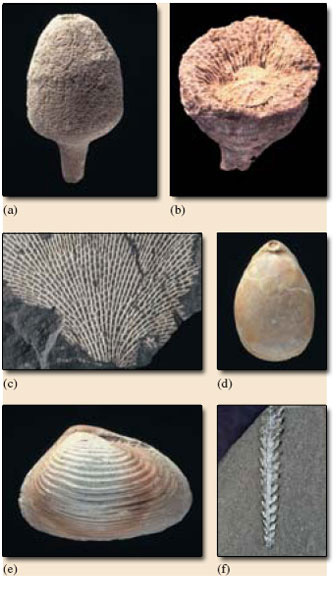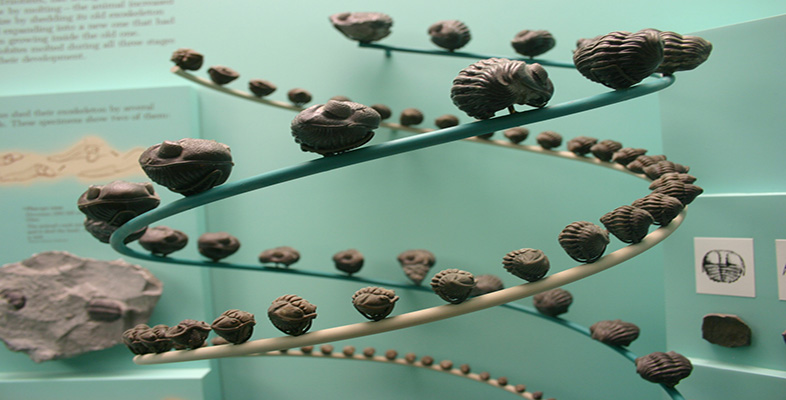1.3 An overview of animal phyla
We have already met quite a few different animal phyla, and it's useful to get an overview of all the ones commonly found in the fossil record and their mode of life before studying some in more detail. Except for a few soft-bodied phyla with very poor fossil records, it is clear that all the animal phyla had appeared by the Ordovician Period.
Modes of life
The following terms are very useful for describing the mode of life and the environmental setting of organisms. The terms are explained here as they are applied to marine organisms, but they are also sometimes applied to organisms living in lakes.
benthic - animals and plants that live on the sea floor; collective noun: benthos.
pelagic - animals and plants that live above the sea floor. They may be either nektonic (animals only) or planktonic (animals and plants).
nektonic - animals that swim actively (e.g. fish, squid); collective noun: nekton.
planktonic - animals and plants that drift passively or swim feebly, mainly in the surface waters of seas; collective noun: plankton. The term includes phytoplankton (photosynthetic organisms, mostly algae) and zooplankton (mostly microscopic animals, including larvae of larger ones, but also some macroscopic animals that are readily visible with the naked eye, e.g. jellyfish).
epifaunal - animals that live on the sea floor, either on soft sediment, or attached to rocks, seaweed, etc. (sessile), or that move over the sea floor (vagrant); collective noun: epifauna.
infaunal - animals that live within sediment, often in burrows or borings into harder material; collective noun infauna.
Like most classifications involving living organisms, some invertebrates do not fit neatly into these categories, e.g. the common prawn buries itself in sediment during the day (i.e. is infaunal), but at night emerges to join the epifauna as it feeds. Other epifaunal animals bury themselves during low tide.
The following text gives some key points about the important animal phyla most commonly found in the fossil record. The age range and mode of life of some common groups are given, and phyla that are microscopic throughout life are excluded. Figure 1 shows typical fossil representatives of some of the phyla.
Porifera. Sponges. Cambrian to Recent. Mainly marine; some freshwater. Sessile. The simplest multicellular animals, sponges lack definite tissues and organs, e.g. they have no nervous system. They have a skeleton of calcium carbonate, silica, or, as in some bath sponges, horny organic material. Water passes in through the sponge's many surface pores, often to the central cavity of a sack-like body, and out through a large hole at the top. Some have a stalk (Figure 1a), others are encrusting and irregular in shape. Sponges feed by filtering off minute organic particles from the water. Sponges are locally abundant fossils, especially in Cretaceous rocks, where they are very commonly enclosed in flint nodules in the Chalk.
Cnidaria (pronounced with a silent 'C': 'nigh-dare-ee-a'). Late Precambrian (Ediacaran) to Recent. Almost entirely marine. Cnidarians have a central mouth around which are stinging tentacles for catching prey. By far the most important fossil group are the entirely marine, generally benthic, corals, which secrete a skeleton of calcium carbonate below the soft, anemone-like parts at the top. Corals may be either colonial (with many genetically identical, linked individuals sharing a skeleton) or solitary individuals. There are three main groups of corals: rugose corals (solitary, Figure 1b, or colonial), Ordovician to Permian; tabulate corals (always colonial), Ordovician to Permian; and scleractinian corals, sometimes also called hexacorals (solitary or colonial), Triassic to Recent. Sea anemones and jellyfish are also cnidarians, but being soft-bodied these groups are much less common in the fossil record.
Bryozoa. Bryozoans. Ordovician to Recent. Sometimes called 'moss animals'. Normally marine, rarely freshwater. Sessile, tiny animals which live in colonies, with a skeleton usually of calcium carbonate. The colonies vary in shape; some are encrusting sheets ('sea mats'), others may be delicate net-like fronds (Figure 1c) or branching twigs. Each colony consists of a few to thousands of interconnected individuals. When feeding, tentacles filter microorganisms from the water. Bryozoans often occur as fossils among the diverse fauna of reefs. Some bryozoans look rather like small corals; a few species can look a little like graptolites (see below).
Brachiopoda. Brachiopods (pronounced 'bracky-o-pods'). Cambrian to Recent. Entirely marine, benthic animals. Sometimes called 'lamp-shells' (after their resemblance to Roman oil lamps). Brachiopods are typically 2-5 cm long, but they range in size from a few mm to as much as 30 cm. The shell, which encloses the soft tissues, has two parts, called valves. One valve is almost always larger than the other. Many brachiopods are attached to the sea floor by a stalk of horn-like or fleshy material, the pedicle; in fossil brachiopods the presence of this pedicle is indicated by a hole passing through the larger of the two valves (Figure 1d). Some are free-lying on the sea floor, and a few are cemented or attached by spines. In most brachiopods the shell is composed of calcium carbonate, though some are phosphatic. They feed by drawing water into the shell and filtering off food particles with a complex feeding device called a lophophore. Brachiopods are much less abundant and diverse today than during the Palaeozoic and Mesozoic. They are the commonest fossil in many Palaeozoic shallow marine limestones and shales. About 20 species occur today off the British Isles, mostly in deeper waters, and are rarely seen.
Mollusca. Molluscs. Cambrian to Recent. Mainly marine. A very diverse phylum, perhaps numerically the most abundant large invertebrates in the fossil record. There are shelled and unshelled forms. Although at first the six or so living classes may seem unrelated, they represent evolutionary variations on the same theme - the molluscan bodyplan. Three classes, each of which range from Cambrian to Recent, are particularly important, both as fossils and today: the Bivalvia - bivalves (e.g. cockles, mussels and oysters) (Figure 1e); the Gastropoda - gastropods (e.g. slugs and snails); and the nektonic Cephalopoda - cephalopods (e.g. squid, cuttlefish, octopus and nautilus). Most bivalves are marine (vagrant to sessile benthos), though some are freshwater. The majority of gastropods are aquatic, and most of these live in shallow seas, but they are also widespread in freshwater and on dry land. Cephalopods are (and have been) entirely marine, and are the most highly evolved molluscs. The most important fossil cephalopod groups are all forms with chambered shells - the nautiloids (Cambrian to Recent), the familiar spiral-shelled ammonites (Triassic to Cretaceous), and the bullet-shaped belemnites (Jurassic to Cretaceous).
Echinodermata. Echinoderms. Cambrian to Recent. Entirely marine. Most are benthic. Many are vagrant, some are sessile, and a few are free-swimming (nektonic). Most echinoderm skeletons are made of many porous plates of calcite (calcium carbonate) which are very thinly covered with soft tissue. Multipurpose, extendible tentacles called tube feet emerge to the outside, and are used especially in feeding, respiration and locomotion. In many forms there is a distinctive five-rayed arrangement of plates and tube feet. Echinoderm means 'spiny skin', referring to the fact that some groups have spines or hard, warty bumps projecting from the surface. The most common fossil groups are sea urchins (echinoids), Ordovician to Recent, and sea lilies (crinoids), Cambrian to Recent. Two other well-known living groups, both Ordovician to Recent, are starfish (asteroids) and brittle stars (ophiuroids). There are also several extinct groups.
Arthropoda. Arthropods. Cambrian to Recent. The largest phylum of animals, with a great diversity of morphology and mode of life; living forms are found in most possible habitats in water and on land. A partial list of groups includes crustaceans (crabs, lobsters, barnacles and shrimps), insects, millipedes, centipedes, spiders, king crabs, scorpions, mites and several extinct groups, of which the entirely marine, extinct trilobites (pronounced 'try-lo-bites') are the most important. The most characteristic features of the phylum are the hard outer coating (exoskeleton) which is divided into segments, and the paired, jointed appendages which vary in number and function. The exoskeleton, usually of chitin (a strong, lightweight organic material), may be further strengthened by calcium carbonate or calcium phosphate, increasing the preservation potential. Growth occurs during periodic moulting when the exoskeleton is shed and a new, larger one is formed.

Hemichordata*. Hemichordates. Cambrian to Recent. By far the most important fossil group are the graptolites - extinct, entirely marine colonies confined to the Palaeozoic Era, particularly abundant in Ordovician and Silurian rocks where they are very useful zone fossils. Many look like saw blades a few centimetres long on the rock, with 'teeth' on one or both sides of the 'saw' (Figure 1f). The 'teeth' were actually tiny cups that housed individuals which made up the colony and possessed filter-feeding tentacles. Some graptolites were benthic and sessile, but most were pelagic, either drifting or possibly swimming feebly as part of the zooplankton.
*Some biologists place the hemichordates as a subphylum within the Phylum Chordata.
Chordata. Chordates. Cambrian to Recent. All chordates possess a notochord (a flexible rod running along the length of the body). Minor living chordate groups, lacking a vertebral column (backbone), include sea squirts and the lancelet. The major group are the vertebrates, which have bony or cartilaginous skeletons and a head. Today, vertebrates include five classes: fish (Cambrian to Recent), amphibians (Devonian to Recent), reptiles (Carboniferous to Recent), mammals (Triassic to Recent) and birds (Jurassic to Recent). Important extinct reptile groups include the land-dwelling dinosaurs (Triassic to Cretaceous), the marine ichthyosaurs (Triassic to Cretaceous) and plesiosaurs (Jurassic to Cretaceous), and the flying pterosaurs (Triassic to Cretaceous). Vertebrate fossils are relatively rare compared with invertebrates, and are usually only fragments.
